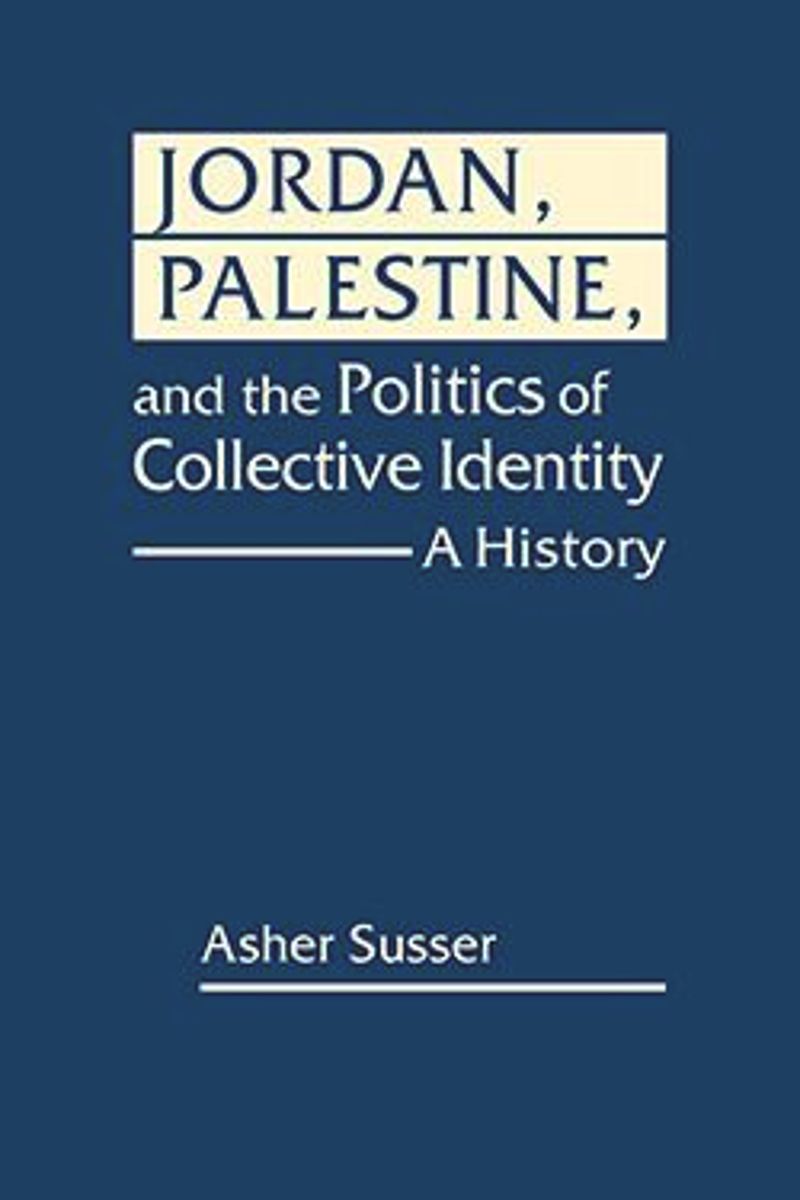|
 Jordan, Palestine, and the Politics of Collective Identity: A History Jordan, Palestine, and the Politics of Collective Identity: A History
By Asher Susser
(Boulder and London, Lynne Rienner Publishers, 2024) 317 pp.
Reviewed by: Dr. Michael Sharnoff, Associate Professor, National Defense University, Near East South Asia Center for Strategic Studies
Asher Susser’s Jordan, Palestine, and the Politics of Collective Identity: A History is an essential, authoritative, and timely contribution to the study of Jordan’s evolving relationship with the West Bank, its Palestinian population, and its national identity. Considering the ongoing Israel-Hamas war and the broader instability in the region, this book is indispensable reading for scholars, policymakers, and practitioners seeking to understand Jordan’s unique position as a stabilizing force amid persistent regional turmoil. As one of the world’s preeminent authorities on Jordan, Susser’s scholarship does not disappoint, drawing on a wealth of primary and secondary sources to provide a rigorous and nuanced analysis of Jordan’s political trajectory. The book’s thematic structure allows for an in-depth exploration of Jordan’s diplomatic history, national identity formation, and the Hashemite monarchy’s resilience—making it a must-read for anyone invested in Middle Eastern affairs.
The first section (Chapters 1–4) masterfully traces Jordan’s political and diplomatic history, from its founding as the Emirate of Transjordan in 1921 to the passing of King Hussein in 1999. Susser’s meticulous research and clear prose provide a compelling narrative of Jordan’s shifting relationship with the Palestinian issue. His analysis of the Hashemite Kingdom’s integration of the West Bank after 1948, an endeavor that sought to incorporate approximately 800,000 (p. 19) Palestinians into Jordanian society, is particularly enlightening. While other scholars have touched on this subject, Susser’s work stands out for its balanced and well-supported assessment of how this integration shaped Jordan’s national identity and ultimately led to its disengagement from the West Bank in 1988. His discussion of Jordan’s evolving role, first as a self-proclaimed guarantor for Palestinian self-determination (p. 68), later as a senior partner with the PLO, followed by an equal partnership with the PLO, and finally as a more distanced interested observer, provides critical insight into the kingdom’s strategic calculations.
The second section (Chapters 5–6) is particularly relevant in today’s political climate, as it delves into the formation of Jordanian national identity, an overlooked topic of paramount importance because fulfilment of an agreed upon Jordanian identity is intimately interlinked with a resolution of the Palestinian question. Susser’s analysis is both incisive and thought-provoking, illustrating how Jordan’s annexation of the West Bank in 1948 fundamentally altered its demographic composition and shaped its evolving sense of nationhood. His discussion of the Hashemite regime’s efforts to foster a cohesive national identity through state-controlled narratives, education, and symbolic representations is invaluable. Given Jordan’s delicate demographic balance, this section offers critical insights into how the state navigates its dual Transjordanian-Palestinian identity and the tensions that arise from it.
While Susser’s discussion of intermarriage between Transjordanians and Palestinians (p. 282) provides a crucial perspective, a deeper exploration of how different generations of Palestinian Jordanians recognize their identity would add even greater depth. Further elaboration on the varying experiences of Palestinians who entered Jordan at different historical junctures, before 1948, after 1948, post-1967, and those without Jordanian nationality, including Gazan refugees, would be of great interest to the reader. Nonetheless, Susser’s argument remains persuasive, and his ability to distill complex identity dynamics into a clear and accessible framework is commendable.
The final section (Chapters 8–11) explores Jordan’s transition from Hussein to Abdullah, and highlights why unlike his father, Abdullah has prioritized Jordan’s security and identity on the East Bank and does not share the same emotional attachment to the West Bank and East Jerusalem (p. 188). These chapters also address the monarchy’s remarkable resilience amidst regional upheavals, a topic that feels especially pertinent today. As neighboring states Egypt, Iraq, and Syria face political turmoil, Jordan has remained a bastion of relative stability. Susser deftly outlines the monarchy’s strategic adaptability, attributing its survival to factors such as a religiously homogenous population, geostrategic position, and a broad Jordanian consensus that the monarchy is essential for the kingdom’s long-term stability and security.
One of the most compelling sections of the book is Susser’s examination of Black September (pp. 1, 55, 58, 108, 145), a watershed moment in Jordanian history. His discussion is both rigorous and insightful, offering a nuanced interpretation of the conflict. However, Susser may consider describing Black September in line with Adnan Abu Odeh’s framing, not as a civil war between Jordanians and Palestinians but as an insurgency between the Jordanian state and the fedayeen.
This distinction is crucial as the conflict was not split neatly along ethnic lines. For instance, Nayyef Hawatmeh, leader of the Democratic Front for the Liberation of Palestine, was a Christian Transjordanian. Some Transjordanians supported and joined the PLO insurgency and most Palestinians in Jordan either remained neutral or sided with the regime. Even King Hussein recognized that had Palestinians in Jordan defected to the PLO, his regime would have collapsed. While Susser’s analysis is already strong, a deeper discussion of shifting loyalties among Jordanians—both Palestinian and Transjordanian—during the crisis would have added further nuance to his argument.
Susser’s coverage of Jordan’s relationship with Israel is equally noteworthy, particularly his assessment of how the rise of Israel’s Likud Party in 1977 (p. 78) reshaped the prospects for a Jordanian-Israeli settlement. His argument that Israel preferred negotiating with Jordan over the PLO between 1967 and 1974 is well-supported, and a more detailed discussion of Israeli and Jordanian hesitations, whether due to domestic legitimacy concerns, regional pressures, or strategic considerations, would have been beneficial. Additionally, Susser rightly emphasizes that under King Abdullah II, Jordan has no intention of reclaiming the West Bank (p. 206). However, since 2012 some prominent Jordanian officials, such as former Crown Prince Hassan and Jawad Anani, have suggested that the West Bank remains a Jordanian land.[i] Others have hinted at a renewed Jordanian role on the West Bank. A more in-depth exploration of why some Jordanian elites would defy King Hussein’s 1988 disengagement decision would have been fascinating.
Finally, Susser’s discussion of Jordan’s use of national symbols, such as stamps, banknotes, textbooks, and mass media, to cultivate a pan-Jordanian identity is both intriguing and well-researched (pp. 98-99, 104, 111-112). These elements play a crucial role in reinforcing the monarchy’s legitimacy, though assessing their actual impact on public perception remains a challenge. Perhaps future scholars will pick up where Susser leaves off by expanding on how these symbols resonate with different segments of Jordanian society—especially younger generations.
Asher Susser’s book is a landmark contribution to the study of Jordanian history and politics. His meticulous research, balanced analysis, and compelling arguments make this work essential for anyone seeking to understand Jordan’s precarious yet vital role in the region. At a time when Jordan’s position is increasingly scrutinized due to the ongoing Israel-Hamas war and Jordanian fears of schemes to transform Jordan into an alternative Palestinian homeland have intensified, Jordan, Palestine, and the Politics of Collective Identity: A History is more relevant than ever.
[i] Jawad Anani, “Jordan’s ‘West Bank,’” Jordan Times, October 23, 2017, https://jordantimes.com/opinion/jawad-anani/jordan%E2%80%99s-west-bank%E2%80%99; “Former Jordanian Crown Prince Hassan Bin Talal: The West Bank Is Part Of Jordan,” Middle East Media Research Institute, October 12, 2012, https://www.memri.org/reports/former-jordanian-crown-prince-hassan-bin-talal-west-bank-part-jordan.
|


 Jordan, Palestine, and the Politics of Collective Identity: A History
Jordan, Palestine, and the Politics of Collective Identity: A History
